Industrial_Control_Panel_Basics.pdf
What is a control panel and why do we use them?
First let’s talk about the basic layout of a panel and why we locate items where we do.
- Many different ways to layout a panel
- Airflow
- Safety
- Field wiring, where do wires enter the panel?
Components of a Control Panel
Let’s go over all the components in the panel and what their intended purpose is.
- Surge Suppressor - Protects against lighting and power surge
- Enclosure and Backplate
- Main Circuit Breaker
- Branch Circuit Breaker
- AC Power distribution
- Power Supply - Converts one form of power to another
- DC Power Distribution
- Ethernet Switch - Allows several different devices within the cabinet to communicate with one another
- Radio - Industrial radio paired with a polyphaser and antenna. Used where the panel cannot communicate locally via ethernet cable.
- PLC (Programmable Logic Controller) - The brains of the operation. Sends and receives data, interprets it, and communicates values we can understand.
- HMI (Human Machine Interface) - Allows interaction with the data collected by the PLC. Commonly mounted on the front of the panel.
- IO - Analog vs Digital signals. Digital Inputs and Outputs
- Relays - Used for digital outputs and many other purposes.
- Wire Duct and Dinrail
Transcript:
[0m:4s] Hi I'm Josh Bloom, welcome to another video in the RSP Supply education series. Today we're going to be talking about industrial control panels:
[0m:12s] What they are, why we use them, and lastly all the different components located within the panel and what their purpose is. Let's first talk about what an industrial control panel is. An industrial control panel is a collection of electrical components that are used to monitor and control industrial devices in industrial applications. For example, the panel we have here today is being used in a pumping facility for a local city. So as you can imagine, it monitors things like pressure within a pipe, or flow, it might send a signal to open or close a valve.
[0m:45s] Now, that we've talked about what control panels do and why we use them let's talk about all the different components within the panel itself and what their purpose is. Now let's look at some of the components located within the actual panel itself. First we're going to start with our main breaker.
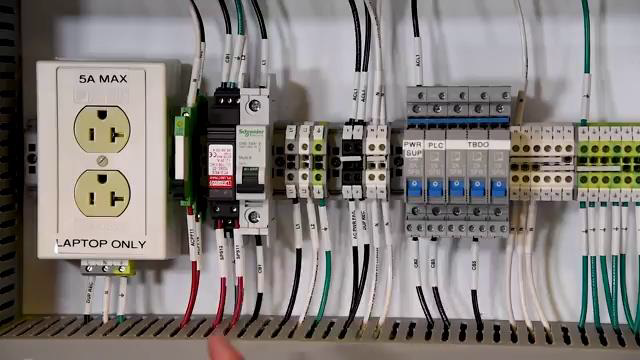
[1m:0s] Where this is located is actually very important. We want to think about where power is going to be coming into our enclosure.
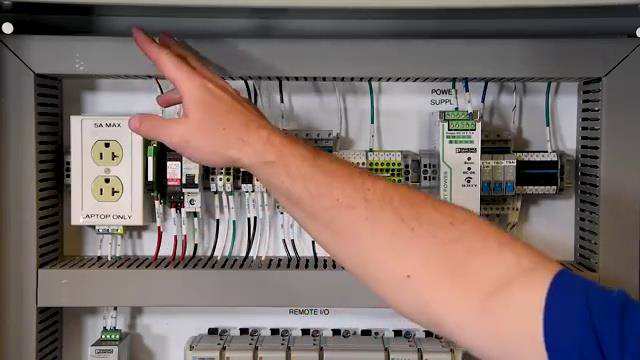
[1m:6s] Power typically comes in at the top of the enclosure, so we typically like to locate our main circuit breaker at the top of the enclosure either on the left side or the right side. We typically see these mounted on the left side.
[1m:19s] This breaker will kill power to everything located within the panel. Next, we have a surge Suppressor.
[1m:26s] The surge suppressors function is to provide protection against a lightning strike or a power surge. It will protect all the components downstream located in the panel itself.
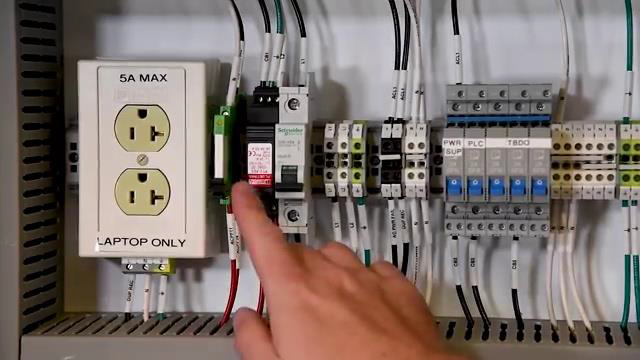
[1m:38s] Moving on, we have our AC power distribution.
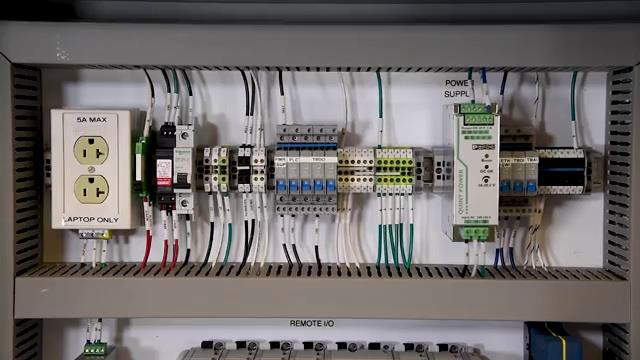
[1m:42s] This is simply where we bring AC power from our main breaker over to this bank of circuit breakers. We have one wire coming in and it connects all the circuit breakers with this jumper bar here. We then send power, AC power in this case, to the components that require AC power within this panel. One component that requires AC power
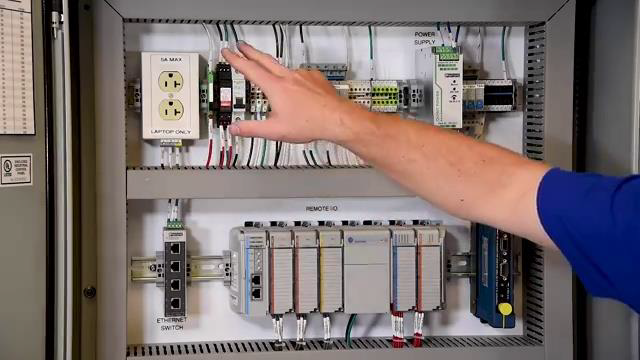
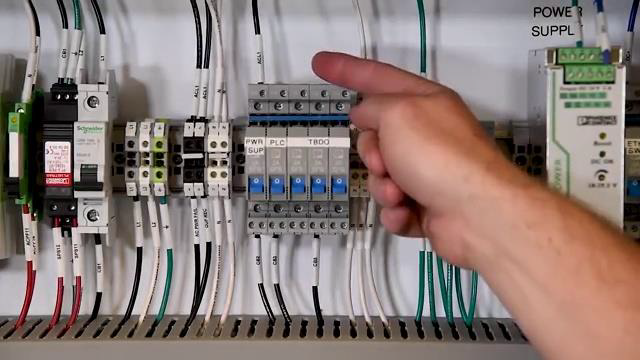
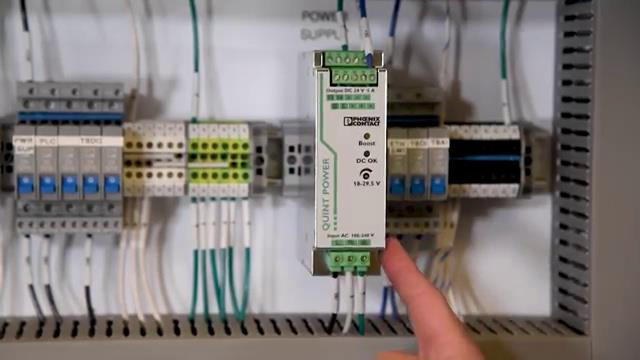
[2m:5s] Is our power supply. Now, the power supplies function is to change one type of power to another type of power. In this case, the power supply takes 120 AC voltage and converts that to 24 volts DC voltage, which is the voltage that's required for the majority of the components within our control panel. From this power supply, we send our DC voltage to our DC power distribution. Just like with our AC power distribution, the DC power has one wire coming in, connects these three circuit breakers together with a jumper bar, and distribute that DC power to the components within our control panel. Moving on we're now, going to talk about the Ethernet switch. Much like you might see at home or in your place of business, the Ethernet switch simply allows the devices within the panel to communicate with one another using either a cat 5 or cat 6 cable. Next, we want to talk about our radio. The radio takes the data that comes from the control panel,
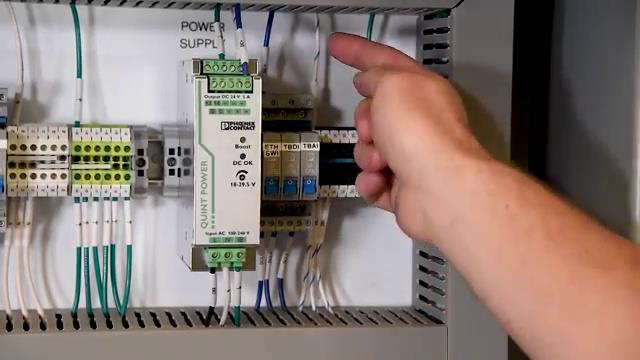

[3m:6s] Transmits that data, and sends it to another location that might be located far away.
[3m:11s] The radio is simply paired with a Polyphaser which provides Lightning protection as well as an industrial radio antenna.
[3m:18s] Now let's talk about the brains of the operation: the PLC, or programmable logic controller. The purpose of the PLC is to send and receive data to the instruments that are wired in the field.
[3m:29s] It takes that data with varying signal types, translates it so that we can understand it, and incorporate that into our distributed control systems.
[3m:37s] Now let's talk about the terminal blocks. The terminal blocks are the connection point which field instruments are wired into our control panel.

[3m:46s] Depending on the instrument, we have varying types of signals.
[3m:50s] Here we have our analog signals. Analog signals measure a range of values such as a tank level or water pressure.
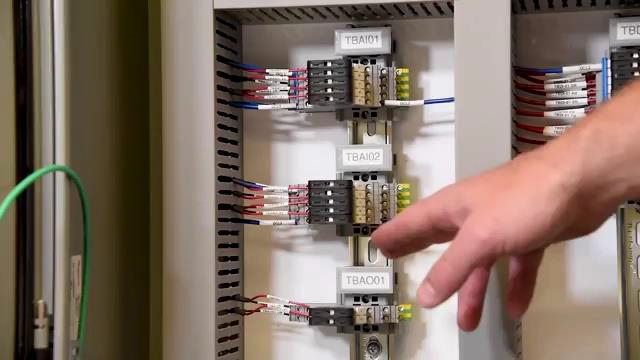
[4m:0s] Here we have the terminal blocks that measure our digital signals. Digital signals are either on or off. An example of this might be a valve is either open or closed. Lastly, we have this bank of relays that controls our digital outputs. The digital outputs allow us to control higher voltage circuits while using lower voltage signals. It also protects the PLC from over current. As you can see, we have a lot of different components. All of these components are mounted to Dinrail and are surrounded by wire ducting. For more information on Dinrail and wire ducting, please refer to our other video at RSPSupply.com.
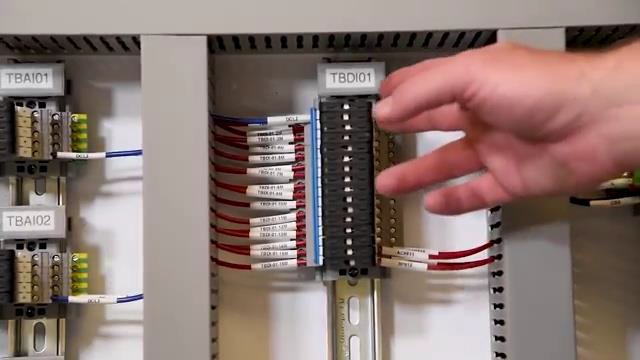

[4m:40s] All of the components within the panel including the wire ducting and din rail, our main to what we call the back plate. The back plate is separate from the actual electrical enclosure itself, and what the back plate allows us to do is fabricate, build, and wire this panel separate from the enclosure.
[4m:57s] When we're ready, we can take the back plate and all the attached components and put it in the electrical enclosure itself. The electrical enclosure provides protection for both components and any operators in the area.
[5m:9s] It is common to make modifications to electrical enclosures. One common modification is to mount what we call an HMI to the door of the enclosure. HMI stands for human machine interface. It allows us to view and manipulate the data being sent and received by the PLC.
[5m:25s] As you can see there's a lot that goes into the design and fabrication of an industrial control panel. However, this is just one variation of thousands of different ways that we can build and fabricate control panels. For a full line of industrial control panel components or thousands of other products, please go to our website.
[5m:43s] For more information or other educational videos, go to RSPSupply.com, the Internet's top source for industrial hardware. Also, don't forget: like and subscribe.




